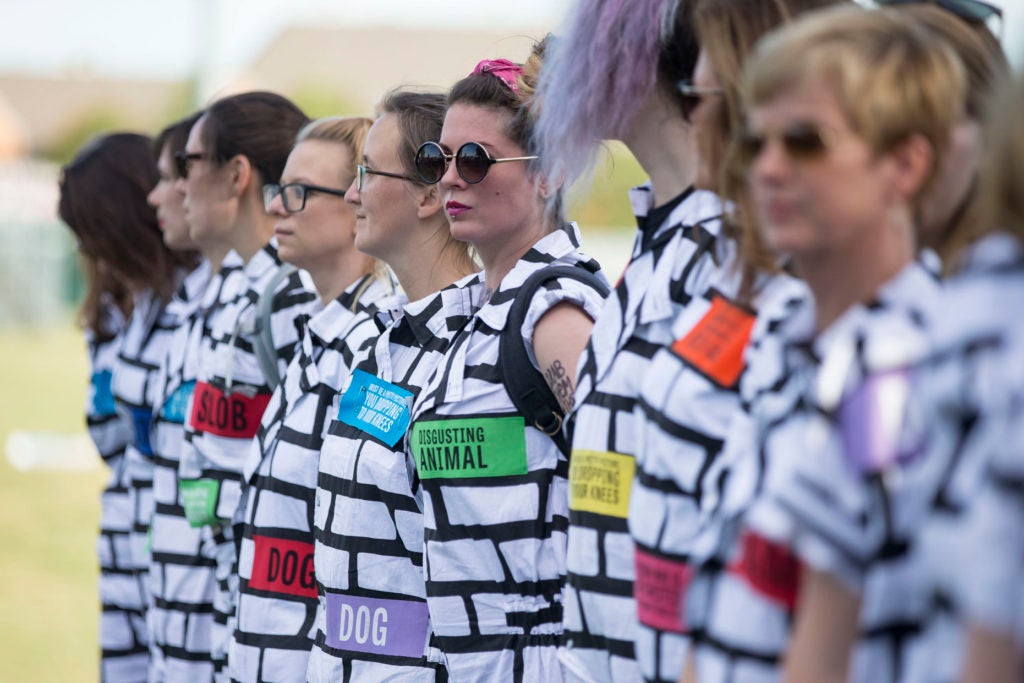
Among the protestors at the designated zone was this group of women with colorful rectangles highlighting statements made by one of the candidates. (Photo: Whitney Curtis/Washington University)
Depending upon whom you asked, only Hillary Clinton or Donald Trump — or Jill Stein or Gary Johnson — could save the United States from economic and social turmoil.
Supporters and opponents of the four presidential candidates comprised the largest groups of demonstrators who assembled Oct. 9 during the hours leading up to the debate between major-party contenders — Democrat Clinton and Republican Trump — at Washington University in St. Louis.
Altogether, more than 300 people peacefully gathered at the university’s Public Expression Zone (PEZ) to express opinions and political dissent on the campus’ Intramural Field, located on the corner of Forsyth and Big Bend boulevards and within close proximity to the debate venue at the Athletic Complex.
“We wanted to give people a dedicated and safe area to express their viewpoints before and during the presidential debate,” said Leslie Heusted, executive director for campus life and director of the Danforth University Center, who shepherded the event for the debate steering committee. “This is especially important with less than a month before the election.”
Just before 4 p.m. Sunday, demonstrators started arriving at PEZ, where they had the opportunity to voice their beliefs in an impromptu manner on the grassy field or, for those who pre-registered, on a sound stage during a set time period of 20 minutes. Although loud, the demonstrators were nonviolent and respectful of everyone’s right to speak.
One registered speaker was Elston McCowan, a Baptist minister who is the Midwest Regional Coordinator for Stein, the Green Party presidential candidate. “We are a diverse political party,” he said. “We value peace and our planet over profit.
“If you feel strongly about these issues, you must vote with your conscience,” McCowan said. “Don’t vote out of fear for a candidate you dislike.”
Supporters of Johnson, the Libertarian presidential candidate, expressed similar sentiments. “If you’re tired of the political fighting in our country, then you need to vote for the candidate you believe in,” said Jonathan Dine, a Libertarian candidate for the Missouri Senate.
Waving signs and donning “Make America Great” baseball caps, dozens of Trump supporters urged demonstrators to vote out established, long-time politicians such as Clinton. “We need new leadership,” one supporter said. “And Trump is that leader.”
Perhaps the most visually compelling group was Brick x Brick, a group of Clinton supporters dressed in jumpers depicting mostly black-and-white bricks.
Interspersed on the outfits were colorful rectangles highlighting statements Trump has made to media about women. When demonstrators stood in a line and joined hands, they represented a “wall against misogyny,” said the group’s leader, Sarah Sandman, an artist. “We want respect for all people. There is no place in White House for misogyny and racisim.”
Other demonstrators spoke on behalf of issues, not the candidates. For example, the American Cancer Society’s Cancer Votes is a nonpartisan organization advocating increased funding for research and improved treatments for the disease. Each year, 1.7 million people in the U.S. receive a cancer diagnosis.
“No doubt everyone is against cancer,” said Keith Whittemore, a prostate-cancer survivor who spoke on the sound stage about the importance of research funding. “We need breakthroughs.”
Another nonpartisan group was Fight For $15, which urges raising the minimum wage to $15 an hour as well as securing union rights for workers.
“I don’t care if you’re a man or a woman, if you’re black, white or blue, if you support us making a living wage so we can put food on our family’s table, then we will vote for you,” said Naqnasia LeGrand, who works at McDonald’s. “Everyone deserves to be able to work to provide for their family, to do the right thing.”